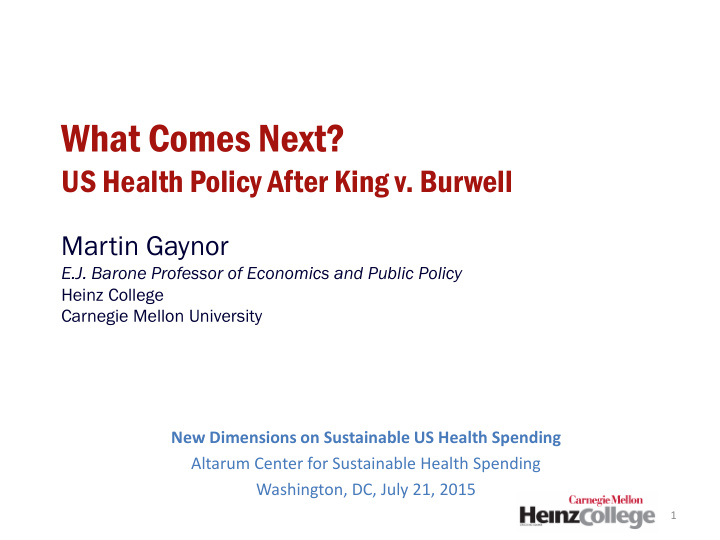



What Comes Next? US Health Policy After King v. Burwell Martin Gaynor E.J. Barone Professor of Economics and Public Policy Heinz College Carnegie Mellon University New Dimensions on Sustainable US Health Spending Altarum Center for Sustainable Health Spending Washington, DC, July 21, 2015 1
Introduction The primary goal of the Affordable Care Act was to expand health • insurance coverage – It has done so, and King v. Burwell ends challenges to a major component of the ACA – Coverage challenges remain • Medicaid expansions • Limits of the ACA: millions of Americans who will remain uninsured Unlikely there will be major additional coverage policy initiatives • Now it’s time to focus on the supply side: spending, prices, quality • – The ACA has components aimed at these things – But more is required – Spending may be ticking up • Whether this time is “real” or not, growth will likely resume 2
Health Care Spending Not a New Problem by Andy Warhol (Pittsburgh native, CMU ‘49) ~ 1985-86 was available via Christie’s $15-20,000 3
Health Care Cost Growth 1961-2014 National Health Expenditures Annual Growth Rate 18.00% 16.00% 14.00% 12.00% Percentage Change 10.00% 8.00% 2014; 6.00% 5.6% 2007; 6.4% 4.00% 2013; 2.00% 3.6% 0.00% Year 4
Policies: Demand or Supply? Demand side policies/”shopping” • – Cost sharing High deductible plans • Reference pricing • Tiered/Narrow networks • – Transparency – Empowerment These are fine, but not realistic to expect them to drive change by • themselves – Those with very high expenses “20/80 rule” • Risk protection • – Information/understanding/biases – Powerful provider incentives Payment • Market power • Need to focus on the supply side • 5
Supply Side Policies Two categories of critical supply side policies • – Payment policy – Competition policy Payment policy • – Use payment incentives to induce providers to “do the right thing” • E.g., bundled payments, ACOs, patient centered medical homes, capitation, bonuses/penalties, value based care, pay for performance,… Competition policy • – Use market incentives to induce providers to “do the right thing” • E.g., antitrust, state rules and regulations, federal rules, regulations, payment policy,… Payment and competition policies can work • – Make things better – Don’t expect 1 st best: this isn’t a market for paper clips 6
Payment & Competition Policies There has been a great deal of focus on payment policy • – Relatively little attention to competition policy Competition policy important in its own right • – US has a market based health care system – If markets don’t function well health reform won’t work – Markets matter for Medicare, Medicaid beneficiaries, not just for the privately insured 7
Payment & Competition Policies are Complements Payment reform won’t work well if there’s little or no competition. • – A dominant provider can simply refuse to accept a new payment model (from a private payer), and they do – A provider with market power will negotiate higher payments/more advantageous terms, no matter the form of payment • If the payment is too high/advantageous, then there’s little or no incentive to do better – Payments can’t do it all – competition serves to discipline behavior • Medicare - quality Competition will work better if payments have better incentives • – Competition can’t do it all – payments provide incentives to focus on right areas – Competition doesn’t necessarily lead to right/best outcomes – Payments can “expand set of competitors” • National standards • Centers of excellence – competing for contracts 8
Competition Policy Making Markets Work Policy levers – many players • Antitrust enforcement (FTC, DOJ, States, CMS?) – Keep going (provider mergers, insurance mergers, pharma mergers, payments) • New approaches/foci • Cross-market mergers – Geographic, Product [DOJ: Time Warner-Comcast] » Vertical mergers – Impacts on Medicare beneficiaries/CMS involvement – Advocacy/information – Consumer protection – Surprise out of network bills • Network information • Patient EHR • Federal agencies (HHS, CMS, FDA,…) – Network adequacy requirements • Surprise out of network bills • Reference pricing • Biologics naming convention • Licensing/regulation • Increased state activity/scrutiny – Licensing/scope of practice • Regs/rules: any willing provider/narrow networks; CON,… • Monitoring (MA HPC; TX ACO review) • Antitrust enforcement • Transparency • 9
Conclusion Expanding insurance coverage has been a critical social goal • – The ACA has achieved a great deal – More remains to be done, but major policy change is unlikely It’s time to focus on the supply side • Payment policy and competition policy are complements • Competition policy has not received enough emphasis • – States and Federal agencies have important roles to play There is, and will be, strong push back against stronger • incentives and tougher competition – Often at the state level – Must not let those efforts succeed 10
Cost Growth Cycles • Reasons for cycles not entirely clear – Business cycle – Attempts to control costs followed by attempts to undo them • Political economy • Private efforts: “gaming” the system – Patients, hospitals, doctors,… • 1970s: wage & price controls (Nixon); “voluntary effort” (Carter) • 1980s: prospective payment system (Reagan) • 1990s: managed care • Parallel phenomena in other countries 11
International Growth in Health Spending, 2000-2011 US Source : OECD Health Statistics 2013, OECD (http://www.oecd.org/health/healthdata) 12
Recommend
More recommend